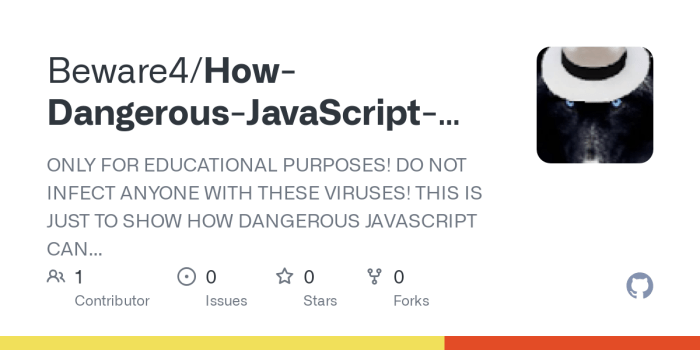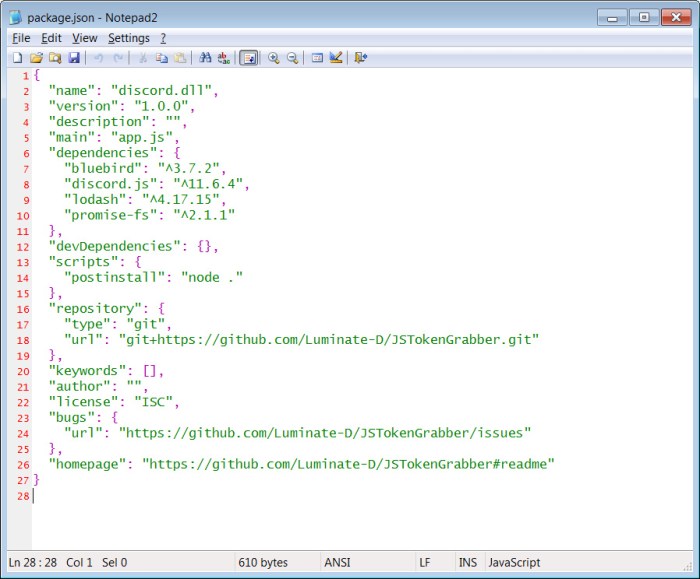Weaponized JavaScript projects: Sounds like a villain’s plot straight out of a cyberpunk movie, right? But the reality is far more insidious. This isn’t about some futuristic dystopia; it’s about the very real threat of malicious code lurking in seemingly harmless websites, ready to steal your data, hijack your system, or worse. We’re diving deep into the dark art of weaponized JavaScript, exploring the techniques, the impact, and – crucially – how to protect yourself from this digital menace.
From understanding the different attack vectors like cross-site scripting (XSS) and drive-by downloads to dissecting the obfuscation techniques used to hide malicious code, we’ll unravel the complexities of these attacks. We’ll examine how these projects are delivered – from phishing emails to compromised websites – and the devastating consequences they can unleash on individuals and organizations alike. Prepare to uncover the secrets behind this digital threat and learn how to safeguard yourself and your data.
Defining “Weaponized JavaScript Projects”
Think of JavaScript as the engine that makes websites interactive. But like any powerful tool, it can be used for good or evil. Weaponized JavaScript projects leverage the language’s capabilities to deliver malicious code, often hidden within seemingly harmless websites or applications. These projects are designed to exploit vulnerabilities in browsers and operating systems to achieve nefarious goals, ranging from data theft to complete system compromise.
Weaponized JavaScript projects are essentially malicious programs written in JavaScript. They’re deployed using various techniques to trick users into executing the harmful code, often without their knowledge or consent. The result can be anything from annoying pop-ups to devastating data breaches and complete system control by the attacker. Understanding these projects requires looking at both their intent and the ways they function.
Categories of Weaponized JavaScript Projects
Several categories exist, each utilizing different attack vectors. These methods exploit various weaknesses in web browsers and user behavior.
- Cross-Site Scripting (XSS): This is a classic attack where malicious JavaScript code is injected into a legitimate website. When a user visits the compromised site, their browser executes the injected code, potentially stealing cookies, session tokens, or other sensitive information. Imagine a seemingly harmless forum where a malicious user posts a link containing hidden JavaScript. When a user clicks the link, the code runs on their machine, potentially granting access to their online accounts.
- Drive-by Downloads: These attacks involve automatically downloading and executing malware onto a user’s computer without their explicit consent. The malicious JavaScript code could exploit a browser vulnerability to download and install a virus or other harmful software. This often happens when visiting compromised websites or clicking on infected links, where the malicious script silently downloads malware in the background.
- Phishing Attacks: While not solely reliant on JavaScript, it often plays a crucial role. Malicious JavaScript can create convincing fake login pages or forms, designed to steal user credentials. These sophisticated attacks leverage JavaScript to mimic the look and feel of legitimate websites, tricking users into entering their sensitive information.
Motivations Behind Weaponized JavaScript Projects
The motivations behind creating and deploying these projects are diverse and often financially driven.
- Financial Gain: Stealing credit card information, banking details, or other sensitive financial data is a primary motivation. Attackers can sell this information on the dark web or use it for fraudulent activities.
- Espionage and Data Theft: Government agencies or corporations may use weaponized JavaScript to steal intellectual property, trade secrets, or confidential information from competitors or adversaries.
- Political Activism or Sabotage: In some cases, malicious JavaScript projects might be used for acts of cyber vandalism or to disrupt online services for political or ideological reasons. This could range from defacing websites to launching denial-of-service attacks.
- Malware Distribution: Weaponized JavaScript is a common method for distributing various types of malware, from ransomware to keyloggers. The script acts as a delivery mechanism, exploiting vulnerabilities to install the harmful payload on the victim’s system.
Common Techniques Used in Weaponized JavaScript

Source: com.sg
So, you think JavaScript is just for making websites flashy? Think again. The same language that powers interactive web experiences can also be weaponized, creating serious security risks. This isn’t about blaming JavaScript itself; it’s about understanding how malicious actors exploit its capabilities for nefarious purposes. Let’s dive into the sneaky tactics they employ.
Weaponized JavaScript relies on a combination of obfuscation, evasion techniques, and exploitation of vulnerabilities to deliver its payload. The goal is always the same: to gain unauthorized access to a user’s system or data, often without the user even realizing it’s happening. This requires a deep understanding of both JavaScript and the security mechanisms designed to protect against it.
Obfuscation Techniques
Obfuscation is the art of making code difficult to understand. Malicious actors use it to hide the true purpose of their JavaScript code, making it harder for security researchers and antivirus software to detect and analyze. Several techniques are commonly employed. These techniques range from simple character replacements to complex transformations that restructure the code entirely.
Evasion Techniques
Evading security software is a crucial aspect of weaponized JavaScript. Attackers employ various methods to bypass antivirus programs, firewalls, and browser security features. These techniques often involve dynamically generating malicious code, using polymorphism (changing the code’s structure while maintaining functionality), and exploiting vulnerabilities in security software itself. The constant arms race between attackers and defenders makes this a constantly evolving landscape.
Exploiting Browser Vulnerabilities
Web browsers and their plugins are frequent targets for weaponized JavaScript. Attackers search for vulnerabilities – flaws in the software’s code – that can be exploited to gain unauthorized access or execute malicious code. These vulnerabilities can range from memory corruption issues to cross-site scripting (XSS) flaws. Once a vulnerability is found, attackers craft JavaScript code to trigger it, allowing them to execute arbitrary code on the victim’s machine. This often leads to data theft, system compromise, or the installation of malware.
| Technique | Description | Example Code Snippet (obfuscated) | Deobfuscated Code Snippet |
|---|---|---|---|
| String Encoding | Replacing characters with their Unicode or ASCII equivalents. | eval(unescape('%76%61%72%20%78%3d%22%48%65%6c%6c%6f%22%3b%20%61%6c%65%72%74%28%78%29%3b')) |
var x = "Hello"; alert(x); |
| Control Flow Obfuscation | Using complex conditional statements and loops to make the code’s execution path difficult to follow. | for(var i=0;i<10;i++)if(i%2)a[i]=i;elsea[i]=i*2; |
var a = []; for(var i=0; i<10; i++) a[i] = (i%2) ? i : i*2; |
| Packing/Compression | Reducing the size of the code to make it harder to analyze. | eval(atob('dmFyIHg9IkhlbGxvIjthbGVydCh4KTs=')) |
var x = "Hello"; alert(x); |
| Function Hiding | Hiding function definitions within other functions or variables. | (function()var a=function()alert('Hidden!');;a();)(); |
alert('Hidden!'); |
Delivery Mechanisms of Malicious JavaScript
Slipping malicious JavaScript into unsuspecting systems is a bit like a digital heist – the success hinges entirely on how cleverly the bad actors deliver their payload. Understanding these delivery methods is crucial to building effective defenses. It's a cat-and-mouse game, with attackers constantly evolving their tactics to bypass security measures.
The effectiveness of a delivery method depends on a number of factors, including its sophistication, the target's technical skills, and the current state of security software. Detection difficulty varies widely, from easily spotted phishing emails to highly camouflaged attacks on seemingly legitimate websites.
Phishing Emails
Phishing emails remain a popular delivery method due to their simplicity and effectiveness. Attackers craft convincing emails that mimic legitimate communications, often from banks, online retailers, or other trusted sources. These emails typically contain malicious attachments or links that, when clicked, download and execute the weaponized JavaScript code. The success of this method relies on social engineering – manipulating users into trusting and interacting with the malicious content. A well-crafted phishing email can easily bypass basic security measures, especially if it targets individuals with less technical expertise.
Malicious Websites
Directly visiting a malicious website is another common vector for weaponized JavaScript. These sites might appear legitimate at first glance, often mimicking popular websites or services. However, the site's code contains malicious JavaScript that executes automatically when the user visits the page. This could involve drive-by downloads of malware, data theft, or the installation of browser extensions that further compromise the user's system. The effectiveness of this method depends on the attacker's ability to create a convincing website and lure victims to visit it, often through search engine optimization or advertising campaigns. Detection can be challenging, as the malicious code might be well-hidden within the legitimate website code.
Compromised Legitimate Sites, Weaponized javascript projects
A more sophisticated approach involves compromising legitimate websites and injecting malicious JavaScript into their code. This method leverages the trust users already have in the website, making it more likely that they will interact with the malicious code without suspicion. The attacker might exploit vulnerabilities in the website's software or gain access through phishing attacks against the website's administrators. Once compromised, the malicious JavaScript can be seamlessly integrated into the site's code, making it extremely difficult to detect. This method is highly effective because it bypasses many security measures that rely on identifying malicious websites or URLs.
Hypothetical Scenario: A Sophisticated Delivery Mechanism
Imagine a scenario where a sophisticated threat actor compromises a popular online news website. They subtly inject malicious JavaScript code into the site's advertising system. This code, designed to evade detection by antivirus software and content security systems, waits for a specific trigger – for example, a user visiting the site from a specific geographic location and accessing a particular article. Upon triggering, the code silently downloads and executes a more advanced piece of malware, designed to exfiltrate sensitive data or perform other malicious actions. This sophisticated attack leverages the trust users have in the news website, while using advanced techniques to evade detection and ensure a targeted impact. The attack's success relies on a combination of social engineering, advanced programming techniques, and the exploitation of vulnerabilities in both the advertising system and the users' browsers or operating systems. This example highlights how attackers can use seemingly innocuous mechanisms to deliver highly effective and difficult-to-detect malicious payloads.
Impact and Consequences of Weaponized JavaScript

Source: githubassets.com
Weaponized JavaScript, when successful, can wreak havoc on both individual users and entire organizations. The consequences extend far beyond a simple annoyance; they can lead to significant financial losses, reputational damage, and even legal repercussions. Understanding the potential impact is crucial for developing effective preventative measures and mitigating the damage when attacks occur.
The severity of the impact depends on several factors, including the sophistication of the attack, the vulnerability exploited, and the security posture of the targeted system. A seemingly minor script could trigger a cascade of events leading to a major breach, while a more complex attack might be easily thwarted by robust security practices. Regardless of the scale, the consequences can be devastating.
Financial Losses from Weaponized JavaScript Attacks
Successful attacks can lead to significant direct and indirect financial losses. Direct losses might include the cost of remediation, data recovery, legal fees, and regulatory fines. Indirect losses can be even more substantial, encompassing lost productivity, damage to brand reputation, and loss of customer trust. Consider the cost of downtime for a large e-commerce platform following a successful attack—millions of dollars in lost revenue could easily accumulate. Furthermore, the costs associated with investigating the attack, notifying affected individuals (in case of data breaches), and implementing improved security measures can be considerable. These costs are often underestimated initially and can balloon over time.
Reputational Damage and Loss of Customer Trust
In today's digital world, reputation is everything. A successful attack, particularly one involving the theft of sensitive data or disruption of services, can severely damage an organization's reputation. The resulting loss of customer trust can be even more damaging than the immediate financial losses. Customers are increasingly wary of companies that fail to protect their data, and a single security breach can lead to a significant drop in sales and market share. The negative publicity generated by such incidents can also make it difficult to attract new customers and investors.
Real-World Examples of Weaponized JavaScript Attacks
Understanding the real-world impact requires examining specific incidents. The following examples highlight the diverse nature of attacks and their consequences:
- Attack: A Magecart attack targeting an e-commerce website. Malicious JavaScript was injected into the checkout process, stealing customer credit card information.
Impact: Thousands of customers had their credit card details compromised, leading to significant financial losses for both the customers and the e-commerce company. The company faced legal action, reputational damage, and a loss of customer trust.
Mitigation: Implementation of robust security measures, including web application firewalls (WAFs), regular security audits, and employee training. - Attack: A drive-by download attack using a compromised advertising network. Malicious JavaScript was delivered to users visiting infected websites, installing malware on their computers.
Impact: Users experienced system slowdowns, data theft, and identity theft. The compromised advertising network faced significant financial losses and reputational damage.
Mitigation: Improved security practices for the advertising network, including better ad verification and malware scanning. User education on safe browsing practices was also crucial. - Attack: A cross-site scripting (XSS) attack targeting a social media platform. Malicious JavaScript was injected into user comments, allowing attackers to steal user session cookies.
Impact: Attackers gained access to user accounts, potentially leading to data breaches, account takeovers, and spread of misinformation. The social media platform suffered reputational damage and lost user trust.
Mitigation: Implementation of robust input validation and sanitization techniques, regular security updates, and user education on phishing and social engineering tactics.
Mitigation and Prevention Strategies
So, you've learned about the dark side of JavaScript – the weaponized kind. Now, let's flip the script and talk about defense. Protecting yourself and your systems from malicious JavaScript isn't about living in a digital bunker; it's about smart, proactive strategies that keep you ahead of the curve. Think of it as digital hygiene – essential for a healthy online life.
Preventing the execution of weaponized JavaScript requires a multi-layered approach, combining user vigilance, robust browser configurations, and server-side security measures. Ignoring any one of these layers significantly increases your vulnerability. It's a holistic strategy, not a quick fix.
Browser Security Settings and Extensions
Browser security settings are your first line of defense. Enabling features like "click-to-play" for plugins (like Flash or Java) prevents automatic execution of potentially harmful code. Similarly, disabling JavaScript entirely – while extreme – is a viable option if you're dealing with particularly untrusted websites. However, this breaks much of the modern web, so it's not a practical long-term solution for most users. Instead, carefully managing browser permissions and regularly reviewing installed extensions is key. Many malicious extensions masquerade as helpful tools, so scrutinize the permissions each extension requests before installing. Choose extensions from reputable sources and regularly check for updates. A compromised extension can easily act as a backdoor for attackers.
Regular Software Updates and Security Patching
Think of software updates as vaccines for your digital world. They patch security vulnerabilities that attackers exploit to inject malicious JavaScript. Keeping your operating system, browser, and all other software up-to-date is paramount. This includes not just major updates but also the smaller, often overlooked security patches. These updates frequently address specific vulnerabilities that could allow attackers to execute malicious code. For example, a seemingly minor update to your web server software might fix a critical flaw that could allow the injection of JavaScript into your website's content. Failing to update leaves your systems exposed to known threats. Schedule automatic updates whenever possible, and enable automatic security patching.
Server-Side Security Measures
While browser-side defenses are crucial, the server is your last bastion of defense. Server-side security focuses on preventing malicious JavaScript from ever reaching the user's browser. This involves techniques like input sanitization, which carefully cleanses user-supplied data before it's processed by the server or incorporated into website content. This prevents attackers from injecting malicious JavaScript through forms, comments, or other user input fields. Content Security Policy (CSP) headers are another critical tool. CSP allows you to define a whitelist of sources from which the browser is allowed to load resources, including JavaScript. By restricting this to trusted domains, you significantly reduce the risk of loading malicious scripts. Regular security audits and penetration testing are also essential to identify and fix vulnerabilities before attackers can exploit them. A recent example of a successful server-side mitigation involved a major e-commerce site implementing a robust CSP header after a series of cross-site scripting (XSS) attacks. The implementation significantly reduced the success rate of future attacks.
Advanced Weaponization Techniques: Weaponized Javascript Projects
Modern JavaScript malware goes far beyond simple script injections. To truly understand the threat, we need to delve into the sophisticated techniques attackers employ to evade detection and wreak havoc. These advanced methods make traditional antivirus solutions less effective, demanding a deeper understanding of the underlying mechanisms.
Polymorphic JavaScript employs code obfuscation and transformation techniques to create multiple variations of the same malicious code. This makes it extremely difficult for signature-based antivirus software to detect, as each version presents a unique "fingerprint." Imagine a chameleon changing its colors – the core functionality remains the same, but the appearance constantly shifts, rendering static detection methods useless. The attacker might use a variety of techniques, including encryption, code packing, and dynamic code generation, to make each iteration different, significantly hindering analysis and detection.
Polymorphic JavaScript and Evasion
Polymorphic JavaScript uses various techniques to alter its code's structure while maintaining its functionality. This dynamic nature frustrates static analysis and signature-based detection methods. For example, a malicious script might use encryption to hide its payload, decrypting it only during execution. The decryption key could be dynamically generated, further increasing the difficulty of analysis. Another method involves using code generation techniques, where the script dynamically creates new code based on environmental factors. This creates a virtually unlimited number of variations, all capable of performing the same malicious actions.
Self-Modifying Code in Malicious JavaScript
Self-modifying code takes polymorphism a step further. The malicious script actively alters its own code during execution, making it even harder to analyze and detect. This technique involves dynamically rewriting instructions, changing variable names, or even altering the program's flow based on runtime conditions. Consider a scenario where a script checks for the presence of a specific antivirus program. If detected, it modifies its own code to evade detection, essentially playing a cat-and-mouse game with security software. The complexity and unpredictability of self-modifying code pose a significant challenge to traditional security measures.
Bypassing Sandboxing Mechanisms
Sandboxing is a common security mechanism designed to isolate potentially harmful code from the rest of the system. However, sophisticated attackers have developed techniques to circumvent these sandboxes. These techniques exploit vulnerabilities in the sandbox's implementation or use clever manipulation to escape its confines. For example, a malicious script might attempt to exploit a vulnerability in the sandbox's communication channels, allowing it to interact with the host system beyond the sandbox's restrictions. Another method could involve using techniques like cross-site scripting (XSS) vulnerabilities to inject malicious code into the sandbox's environment, allowing it to execute privileged commands.
Sophisticated Attack Flow
Imagine a scenario where a user visits a seemingly benign website. The website secretly downloads a small, seemingly harmless JavaScript file. This file, however, is a polymorphic script that decrypts itself and dynamically generates additional code, evading initial detection. The generated code then attempts to exploit a known vulnerability in the user's browser or operating system to bypass the sandbox. Once the sandbox is breached, the script establishes communication with a command-and-control server, downloading further malicious payloads. These payloads could range from stealing sensitive data to installing ransomware, all while continuing to modify its own code to avoid detection, creating a continuously evolving and highly adaptable threat. This entire process occurs subtly and rapidly, often leaving minimal traces for forensic analysis.
Legal and Ethical Considerations
Weaponizing JavaScript, while technically impressive, treads a very fine line legally and ethically. The potential for misuse is immense, leading to significant consequences for both the creators and victims of such attacks. Understanding the legal ramifications and ethical responsibilities involved is crucial for anyone working with JavaScript, especially in contexts that might involve security or sensitive data.
The legal landscape surrounding weaponized JavaScript is complex and varies by jurisdiction. Creating and distributing malicious code, regardless of the language used, is generally illegal. Depending on the intent and the resulting damage, charges could range from minor infractions to serious felonies, potentially involving hefty fines and imprisonment. For example, distributing malware that steals financial information could lead to prosecution under laws related to identity theft and fraud, while attacks targeting critical infrastructure could attract even more severe penalties. Civil lawsuits from victims seeking compensation for damages are also a real possibility. The legal definition of "malicious" can also be ambiguous and depends on the specific actions and intent of the attacker.
Legal Implications of Creating and Distributing Weaponized JavaScript Projects
The creation and distribution of weaponized JavaScript projects fall under various legal frameworks, depending on the nature of the attack and the jurisdiction. Laws addressing computer crime, fraud, theft, and data protection are all relevant. For instance, the Computer Fraud and Abuse Act (CFAA) in the United States covers unauthorized access to computer systems, which could encompass many forms of JavaScript-based attacks. Similarly, the UK's Computer Misuse Act 1990 prohibits unauthorized access to computer material, modification of computer material, and unauthorized access with intent to commit further offenses. International treaties and conventions also play a role in addressing cross-border cybercrime involving malicious JavaScript. The specific legal consequences depend on factors like the severity of the damage caused, the intent of the attacker, and the applicable laws in the jurisdiction where the crime occurred. A crucial aspect is proving intent, which can be challenging but is often central to the prosecution of such cases.
Ethical Responsibilities of Developers in Preventing the Misuse of JavaScript
Developers have a significant ethical responsibility to prevent the misuse of their skills and the technologies they create. This involves acting with integrity, considering the potential consequences of their work, and adhering to professional codes of conduct. The potential for harm from weaponized JavaScript is substantial, making it ethically imperative for developers to prioritize security and responsible disclosure. This means actively seeking vulnerabilities in their own code and reporting them responsibly to relevant parties, rather than exploiting them for malicious purposes. Furthermore, developers should strive to build secure and robust applications, minimizing the attack surface and making it harder for malicious actors to exploit weaknesses. Education and awareness are also crucial; developers should be well-informed about the ethical implications of their work and participate in efforts to improve overall cybersecurity. This includes promoting best practices, contributing to open-source security projects, and participating in discussions about ethical hacking and responsible disclosure.
Last Recap

Source: medium.com
The world of weaponized JavaScript projects is a constantly evolving landscape of digital threats. While the techniques used are sophisticated, understanding the underlying principles and employing proactive security measures is crucial. From strengthening your browser settings and regularly updating your software to implementing robust server-side security, a multi-layered approach is essential to mitigate the risks. Staying informed about the latest threats and best practices is the best defense against these attacks. Remember, vigilance is your strongest weapon in this digital war.


